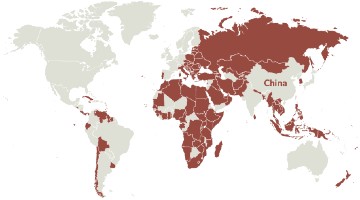A shout out to Refinitiv and the fourth edition of their BRI Connect: An Initiative in Numbers report released this month. Our thoughts thereon:
Refinitiv calculate that there are now 1,590 BRI projects (i.e. an MOU or a joint statement of cooperation has been signed between China and the host country; the map shows which) worth $1.9 trillion; plus 1,574 projects with Chinese involvement as owner, consultant, contractor or financier, worth a further $2.1 trillion.
Yes, many will never happen – projects worth $64.3 billion are on hold, $14.8 billion delayed and $12.8 cancelled – but that still leaves $3.3 trillion considered active and projects worth $593 billion have, in fact, been completed.
Yes, progress has slowed due to Covid 19 and only $137 billion of projects were announced in Q1 2020 (only!).
Yes, some of the debt service will need to be waived / extended / restructured. After all, the Institute of International Finance estimates that $280 billion has been invested by China into countries rated sub-investment grade / not rated in the first place. These are countries which the West would often not lend to at all; but Hambantota port in Sri Lanka remains the only example of Chinese lenders exercising their security as allowed for in every project financing; so allegations of “debt trap diplomacy” are unfounded.
By the same token, much of BRI has gone to countries which can, in fact, afford to repay such as Saudi (second after only Russia) and (for the moment) the UK (fourth).
Another yes, much of the lending to date has been on terms less than best market practice but they will improve. China’s policy banks still carry much of the burden of BRI and need the outside World to share that burden; and despite having been established by Beijing, the AIIB will lend only on terms more akin to the Bretton Woods development banks such as the World Bank or ADB; so, at the second Belt and Road Forum last year, Xi Jinping promised higher standards; the G20 (including China) endorsed a set of principles for quality infrastructure at their meeting in Osaka last year; and Covid 19 will bring greater scrutiny again of all matters ESG.
Refinitiv estimate that 26% of all projects, i.e. $1.03 trillion, involve the private sector. Even Beijing’s coffers have some limit so outside funding is again welcome particularly when this is in the form of project finance, bringing as it does much higher levels of due diligence and controls over how the project is built then operated.
As ever, the success of BRI will depend on two sets of players outside China’s control.
First, host governments need to decide what projects should be built each in their own country: they need to scope these projects i.e. assess the demand for them; determine their location, size or route; set the legal and regulatory environments within which the projects are to sit; place values on the costs and benefits external to each project; and structure any necessary financial support for the offtaker and / or the project itself (Logie Group stands ready to advise).

Second, there is competition for BRI. Japan has long been the major investor into Asia but other major players have been slow to respond. In September last year, Japan and the EU launched their Sustainable Connectivity and Quality Infrastructure programme; two months later, Japan’s JBIC, the US’ DFC (previously OPIC) and Australia’s DFAT launched the Blue Dot Network to certify standards of transparency, sustainability and development impact for infrastructure projects – what Robert O’Brien, US national security advisor, likened to a Michelin guide for infrastructure (Mmm, did the name come off a menu?). More directly, the three governments intend investing into / lending to such projects and other like – minded sovereigns are invited to join: further details to follow.
The US is in any event returning to the fray – USEXIM has just committed $4.7 billion to two LNG trains in Mozambique despite Anardako selling out of the project last year.
Nonetheless, after discounting for all of the above, BRI is still getting an awful lot of infrastructure built.







